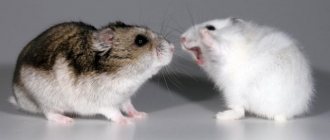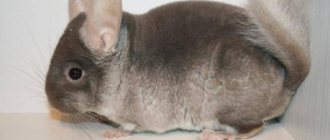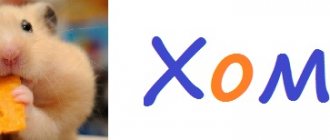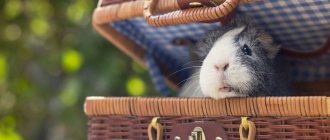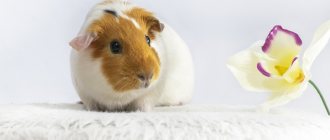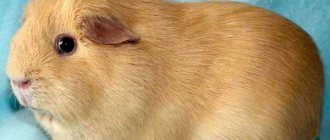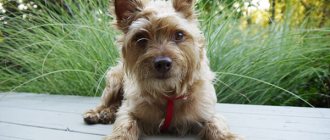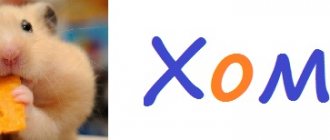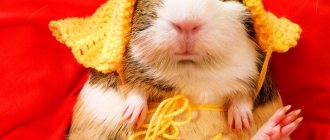The Norfolk Terrier or Norfolk Terrier is one big contradiction. These little toy-looking creatures are actually tough and resilient working dogs, they are brave, smart and independent, but at the same time playful, affectionate and loyal. The Norfolk Terrier comes from Great Britain, where it is one of the popular breeds. It is not numerous outside its homeland, but every year it attracts more and more attention.
Breed characteristics
| Short description | |
| Origin: | Great Britain |
| Conditions of detention: | In an apartment, in a house |
| Purpose: | Hunting, pet |
| Color: | Red; Black and Tan; Wheat; Black and gray |
| Wool length: | Short to medium length (determined by body part) |
| Adult dog size: | Height at the withers - 25 cm. Weight and gender differences are not established by the FCI standard. |
| Average life expectancy: | 14-16 years old |
| Walk: | Twice a day |
| Physical activity needs: | Moderate |
| Fédération Cynologique Internationale (FIC) classification: | Group No. 3 Terriers; No. 2 Small size terriers |
| Puppy price: | 30,000-65,000 rub. Pet class – 30-40,000 rubles. Breed class – 40-50,000 rubles. Show class – 50-65,000 rubles. |
Pregnancy
The gestation period of Norfolk Terriers lasts 51-56 days. Too early or late birth can lead not only to the death of the litter, but also to serious problems with the health of the bitch. During this time, you need to strengthen your diet and also give your dog vitamin supplements. The number of litters reaches up to 4 puppies; during the first pregnancy, their number is usually less.
To avoid various problems during childbirth, it is better to seek the help of a qualified veterinarian. Before whelping, the bitch should be given a mild laxative to cleanse the intestines and carefully monitor the animal’s condition. Norfolk Terriers have good maternal instincts; there are no problems with raising offspring.
https://www.youtube.com/watch?v=WFbc-e_CF-Y
History of the origin of the species
In their homeland, these dogs were used by farmers for burrow hunting and protection from rodents . Rats, foxes, badgers and other small predators became his prey. Due to the nature of its use, selection was focused on obtaining a stocky, small dog with a decisive disposition. Bushy eyebrows protected the pets from lumps of earth getting into their eyes.
Information about Norfolk first appeared in the 19th century. Representatives of the breed were kept mainly by residents of the city of Norwich, Norfolk County.
Presumably, the following breeds were used to create such dogs: Dandie Dinmont, Glen of Imaal and Cairn Terrier.
Then in one litter there could be dogs with the same appearance, which had both erect and hanging ears. The breed was recognized in 1932, without division into separate species. It was only in 1964 that dogs with drooping ears received the name Norfolk and formed their own group, and dogs with erect ears began to be called Norwich.
Interesting Facts
Norfolk Terriers are a fairly young breed, and the peak of their popularity has not yet arrived. Some interesting facts will allow you to get to know these dogs better and, perhaps, add more fans to them:
- Norfolk and Norwich Terriers have long been considered one breed. They are indeed very similar. The only difference is the ears: Norwich dogs have erect ears, while Norfolk Terriers have drooping ears. In 1964, the British Kennel Club divided them into two different breeds.
- Norfolk Terrier puppies are born large with a large head. For this reason, babies of this breed are most often born by caesarean section.
- The Norfolk Terrier is considered the symbol of Cambridge University and is very popular as a pet among its students.
- In the 30s of the twentieth century, one of the representatives of this breed was able to destroy 132 rats in a few days of threshing grain.
- Norfolks are low-fertility breeds - their litter usually consists of only 1-4 puppies.
Distinctive features
The FCI rules establish the following requirements for the exterior of dogs of this breed:
- The head is strong, the skull is slightly rounded, wide, and goes into a wedge-shaped muzzle . The stop is well defined. The muzzle is one third shorter than the skull.
- The bite is dense, only scissor-shaped. The teeth are quite large.
- Eyes with an alert expression, rich brown or even black iris, oval in shape.
- The neck is of moderate length but strong.
- The ears are of normal size, in the shape of a triangle with a rounded tip. They hang along the skull, pressed to the cheekbones.
- The tail is straight, normal length or docked. Quite thick, but tapers towards the tip.
- Body with strong bones, compact body and straight back line. The ribs are well defined.
- Legs are straight, with well-defined muscles. Dogs have wide, sloping shoulder blades and short forearms. The stifles are well defined and the hocks are low. Paws are round in shape.
- The movements are creeping, accompanied by an elastic push of the hind legs. The front girdle of the limbs moves in a straight line from the shoulder. The hind legs follow in its wake.
- The coat is hard and feels like wire. A short layer covers the head and ears, a long layer covers the neck and shoulders. There are “sideburns” and “eyebrows”.
Appearance
At the withers, these dogs are 23-28 cm and weigh 4.5-6 kg. Compact build. These are strong pets. Their muscles are well developed.
The skull is convex and quite wide. The shape of the muzzle is wedge-shaped. The eyes are oval and deep set. Their color is dark (brown), almost black. The ears are “V”-shaped and hang forward like an envelope and fit quite tightly to the cheeks. The jaws are strong. Dog lips fit tightly to the teeth.
The neck is medium in length and quite short. Small and straight back. Legs are straight and short. They are muscular and the pet runs fast. The paws are round and have thick pads. The dog holds its tail straight. It is stopped on the 2-3rd day of life. If the tail is not docked, it will appear to be of medium length. It will be thicker at the base and taper towards the end. The dog will hold it high.
On the shoulders and neck the fur will be the coarsest. It fits tightly throughout the body. The hair on the ears and head will be short. Like all wirehairs, the Norfolk has a mustache and beard. According to the standard, there may be a white mark or medallion on the chest, but this is not desirable.
Photo of an adult dog
Education and training
Like other terriers, education and training are required from the first months of life. If you don't take care of your pet, its activity and temperament can develop into aggression towards other animals. This is especially true for males who try to dominate with larger dogs. Dogs of this breed are susceptible to small animals and have no aggression towards people.
You cannot show aggression towards an animal - the Norfolk Terrier is sensitive to such an attitude towards itself, touchy. As part of training a dog, first of all, you need to teach the ability to hear the owner, the command “near” and “come”. Thanks to their developed intelligence, they are able to learn more complex commands and tricks. They can be stubborn. Conduct classes in a playful way, reinforcing the completion of tasks with treats.
Walks
Until old age, Norfolk Terriers love active and long walks in the fresh air. Every day you need to spend at least 2 hours a day with your pet, letting him run out and throw out the accumulated energy. To maintain muscle tone and endurance, be sure to play with your dog. Representatives of this breed love to run after a ball or disc and swim. Tug of war is permissible only after the formation of molars (from 8-10 months) in order to avoid bite pathologies.
Photo: maxpixel.net
Photos of puppies
Norfolk Terrier: description of the breed
Characteristics of the Norfolk Terrier breed describe the dog as a compact, small animal with a strong build. It has a hard, wiry coat. The standard color is often monochromatic: light red, brown, gray or fawn.
White or black inclusions are acceptable. But the spots should be located in certain places and not take up much space. So black inserts on the back or white marks on the sternum and paws are acceptable.
A mustache, beard and eyebrows are formed on the muzzle. They are not very pronounced, but still noticeable. This is a characteristic feature of the breed.
The coat is long on the body, but it should fit snugly to the body and not puff up. The Norfolk Terrier breed standard pays great attention to the shape of the ears. According to the new requirements, they must be hanging.
The height of an adult should not exceed 26 cm. Ideally, the dog reaches a height of 25 cm. There are no restrictions on weight. But practice has shown that exhibition winners weigh from 5 to 5.5 kilograms. This condition also applies to Norfolk girls.
Similar breeds
We have already named the differences between the Norwich and Norfolk Terrier. They are in the shape of the ears. Otherwise the breeds are very similar.
Novice breeders may confuse the Norfolk Terrier and the Yorkshire Terrier. Here attention should be paid to the type of color, coat length and size. Yorkies are smaller and fluffier. Since Yorkshire terriers are more popular in our country, the offspring of Yorkies can be passed off as a puppy of an exclusive breed.
Features of character and behavior
Despite its small size, this dog is a real terrier. He is active, courageous and determined.
Advantages
- They are energetic, lively and playful dogs. They will be happy to accompany their owner on trips to nature and will appreciate active entertainment in the park. They easily find contact with children, who become good play partners for them.
- Norfolk is patient and can tolerate not very careful attitude from kids, although it is better to protect him from such behavior.
- Norfolk has a strong character, he will never cowardly retreat. Despite its small size, the dog will resolutely enter into a fight with a large dog or come to the defense of its owner if strangers encroach on him.
- Norfolks lack aggression and are not excitable or hyperactive. At home, he is a fairly calm dog, balanced, affectionate and responsive.
- He explores the space with curiosity, watches the family and demands his share of love. He is loyal to his owner and usually follows his commands.
- He is good-natured towards strangers and can go after them if the owner is distracted.
Flaws
- The hunting instinct does not always make it possible to live with other animals, especially small ones. The attitude towards cats can be lenient if they were raised together from childhood.
- Norfolks are also capable of bullying large dogs, especially of their own sex, while walking. Dogs of this breed can be jealous of other animals or strangers.
- If you miss training your dog at a young age, you can end up with a spoiled and unbalanced creature.
- The dog will often bark for no reason, ignore the owner’s demands, and spoil things. It is better to start training from the moment the baby appears in the house.
- The Norfolk is prone to digging, so it's a good idea to keep him on a leash or away from your neighbor's lawn.
Psychology
The Norfolk Terrier, whose photos show all the beauty of this dog, is a small but strong dog with a well-developed hunting instinct.
- Curiosity. This quality is extremely necessary for a hunting dog. After all, the dog must look into all the holes in search of the animal. Norfolk can't take away his curiosity.
- Playfulness. The Norfolk Terrier dog will be happy to participate in fun games. This dog will definitely make friends with children.
- Friendliness. Dogs and cats are friends for Norfolk. He will not show excessive aggression in relationships with other animals. True, small pets can be seen as prey.
- Lovingness. The terrier loves to be the center of attention, it is important for him to hear praise, then the dog will please you with exemplary behavior.
Curiosity is an essential quality for a hunting dog. After all, the dog must look into all the holes in search of the animal. Norfolk can't take away his curiosity
Important! The Norfolk Terrier is very active. He needs an equally active owner to share interesting leisure time and sports.
- Stubbornness. The Norfolk Terrier is prone to training, but he needs a firm hand from his owner, who will not let him down.
- Fearlessness. The small terrier does not pay attention to his size and considers himself a formidable dog, capable of protecting his owners from enemies.
Important! Norfolk barks very rarely and only on business - if he notices something wrong, or he is bored.
In the modern world, the hunting skills of the Norfolk Terrier fade into the background. Today he is popular as a companion dog, an active and energetic pet.
Care and maintenance
The Norfolk Terrier does not require much care. The coat must be combed and trimmed. Due to the fact that dogs have floppy ears, a favorable microclimate is created inside the shell for the development of inflammation. Also, under such conditions, it is easy to miss the appearance of a tick. Therefore, ears need to be examined at least once a week, and also done immediately after visiting the parks.
The claws usually grind down on their own, but it is better to have them inspected monthly and trimmed if necessary. Eyes need to be checked once a week, and if inflammation occurs, rinse with chamomile infusion.
Nutrition
The nutrition of Norfolk Terriers can be natural or organized with the help of professional food. The only rule is not to overfeed the dog and dose treats . This breed loves to eat, so it tends to gain excess weight.
Considering the Norfolk's tendency to allergies, you should avoid foods that are dangerous for your pet; all new ingredients should be included in the diet little by little and the reaction should be monitored.
If the choice is made in favor of professional food, then it is better to buy brands of at least premium class, and ideally, holistic. High-quality ingredients are used for their production, and they contain all the necessary vitamins and minerals. The choice of a specific brand depends on the pet’s taste preferences and the state of its health and coat after eating the food.
A natural way of eating involves feeding lean meats, offal, and cereals. Vegetables, unsweetened fruits, fermented milk products, sea fish, eggs will be useful. You should avoid eating bones, fatty, smoked, spicy foods, chocolate, as well as options containing excess salt.
The frequency of meals is determined by age. Adult Norfolk dogs are fed 2 times a day, and puppies are fed according to the following scheme:
- 2-4 months – 5-6 times a day;
- 4-6 months - the daily norm is divided into 4 doses;
- 6-10 months - three times a day.
We recommend that you read a detailed article on the topic: “How and what to feed a dog: types and characteristics of nutrition.”
Health
Pets of this breed have some health problems. Mandatory vaccination is required.
Vaccinations
Vaccination with special vaccines is designed to organize immune protection against major diseases characteristic of dogs. Such problems include:
- plague;
- coronavirus;
- parainfluenza;
- trichophytosis;
- hepatitis;
- rabies;
- leptospirosis;
- parvovirus enteritis.
Vaccination is carried out at 8-9 weeks in puppies, then repeated at 3 months , and subsequently it is carried out once a year . Proper preparation includes giving anthelmintic medications a week before vaccination and monitoring the pet’s health. You cannot vaccinate an animal with a fever or other signs of illness.
For puppies, after vaccination, quarantine must be established for 2 weeks . At this time, children should not go outside or communicate with their relatives. It is also necessary to monitor the dog’s health. If the little Norfolk becomes lethargic, inactive, and his body temperature rises, then you need to contact a veterinarian for help.
Important article on the topic: “Everything you need to know about dog vaccinations.”
Diseases
Norfolk Terriers have some health problems. Typical diseases of the breed include:
- Epilepsy is a congenital problem of cerebral circulation, manifested in periodic seizures.
- Demodicosis is a parasitic disease in which the pathogen lives under the skin, causing persistent itching and hair loss.
- Cataract is a violation of the transparency of the lens, due to which the surface appears bluish and cloudy. Leads to decreased or loss of vision.
- Pancreatitis is an inflammation of the pancreas that leads to destruction of its tissue.
- Corneal ulcer – destruction of the epithelial layer of the ocular surface.
- Cryptorchidism is a genetic abnormality in which the testes in males do not descend to the designated place.
- Polydentia is the simultaneous presence of primary and molar teeth.
- Monorchidism is the absence of a testicle on one side of the male.
- Tumors.
- Cardiovascular problems.
- Respiratory diseases , including aerobic insufficiency.
- Skin irritations, allergies.
Walk
This is a moderately active dog. She needs at least 2 full walks of 30 minutes a day . You can spend time outside playing frisbee, ball, or searching for hidden objects.
Due to the developed hunting instinct and the tendency to organize provocations of other dogs, it is better to keep your pet on a leash while walking, and release it only after unquestioningly practicing the basic commands. It is also worth avoiding flower beds and lawns; the Norfolk may try to find “hidden” prey in the ground.
Read a useful article on the topic: “Dog walking law, what you need to know about prohibitions and fines.”
Grooming
The coat of pets of this breed requires combing with a metal comb 1-2 times a week. It is often undesirable to bathe it; it is better to wipe it with a damp cloth or rinse with water without shampoo.
Norfolk also needs trimming . For pets it is done twice a year, for show dogs much more often. You can determine the need for this procedure by grabbing a tuft of hair with your fingers and pulling. If the hairs need trimming, they will be easily removed.
The exhibition category of dogs requires trimming that is not too short, but carried out in accordance with all the rules. Treatment varies depending on coat texture and color. Grooming of show dogs is not allowed, because... it leads to poor wool growth, softening and thinness.
Pros and cons of the breed
Dogs' fur practically does not shed
Norfolk Terriers have a lot of advantages. Among the advantages of the breed are the following:
- love physical and mental stress;
- highly trainable;
- They have an obedient character and are not prone to whims.
Representatives of the breed also have minor disadvantages. These include:
- have an excessive appetite and may be overweight;
- They cannot stand loneliness and need constant communication.
Mating
It is better to plan a meeting of future parents when they reach 2 years of age. Both must have a pedigree and sufficient achievements in exhibitions; only compliance with these factors will guarantee the production of healthy offspring that meet the requirements for the breed.
You can find a pair for your pet at an exhibition, having met the breeder of the candidate you are interested in, or at a kennel club where Norfolk is registered. Before introducing the future parents, it is necessary to carry out deworming and trim their nails.
The dogs are not fed before the meeting, but are given a good walk. Acquaintance is carried out on the territory of the male, where he feels comfortable and can organize courtship of the female. Re-mating is carried out every other day, sometimes a third meeting is organized after the same period of time.
Read a detailed article on the topic: “Everything you need to know about breeding dogs: appropriate age, what to do if it doesn’t work out, rules and tips.”
Diseases
Norfolk Terriers do not have typical hereditary diseases. In rare cases, epilepsy is observed; if this disease is detected, the dog must be removed from breeding. To ensure your pet is always healthy and active, you need to undergo an annual veterinary examination. It is recommended to have your teeth cleaned at least once every two years.
Vaccinations for Norfolk Terriers
The dog develops immunity by 4 months. The first vaccination is recommended from 2 months, then after 21-28 days, depending on the pet’s well-being. Before this period, it is forbidden to walk to avoid contracting dangerous infections. Modern vaccines, for example, Nobivac, are complex - they protect against a number of diseases (distemper, leptospirosis, infectious hepatitis, parvovirus enteritis and others). Rabies vaccinations should be given no earlier than 3 months. After the procedures, check for the doctor’s stamp and sticker in your passport.
Photo: wikimedia.org
Key points in training
Norfolk Terriers are quite smart and can easily learn commands. However, they are often distracted by external stimuli and show stubbornness or cunning. Following commands is not intended to earn praise, but rather to get a treat or play. Therefore, consistency and patience are necessary in education and training.
The dog will not appreciate rudeness and the use of force; it is better to build training in the form of a game, encouraging the execution of commands with treats.
It is better to select a variety of exercises so that your pet does not get bored with them, and also to limit the time spent practicing one command to a short period of time.
Read about how to properly train a dog in the article: “Training a puppy: effective methods from dog handlers, learning commands at home.”
Attitude towards children and pets
Can also be carried in a backpack
When getting any dog, an experienced owner will carefully study such characteristics as relationships with children. Well, here the Norfolk Terrier is above all praise. He loves children and is ready to spend hours on end playing with them. And the risk that he will bite them is close to zero - unless he is completely driven to death or even poses a danger to his life.
But relationships with other dogs don’t work out. He perceives larger ones as rivals - this little terrier is surprisingly cocky. And the small ones are nothing more than prey. This is especially true for rabbits, cats, guinea pigs and other pets - the dog may well strangle them and bring them to the owner, waiting for praise.
How to choose a puppy
Kids of this breed should be very active, but balanced. When meeting representatives of the litter, it is worth attracting the attention of the puppies and assessing their behavior. A suitable pet should not be afraid, hide among others, or show aggression or excessive excitability.
A Norfolk baby must have a registered certificate of origin, as well as a veterinary passport, which indicates the vaccinations and dewormings performed. He cannot have discharge from the eyes, matted hairs, or skin irritations. It is worth considering that a baby’s fur is softer than that of an adult dog. His parents must have pedigree and exhibition achievements.
To buy a suitable pet, you should contact a specialized breed nursery. Only healthy dogs with a pedigree can guarantee the origin of the puppy, its health and conformity to the exterior.
A pet bought secondhand can grow into a dog that is not even remotely similar to a Norfolk.
Health
The Norfolk Terrier is distinguished by good health and endurance. The life expectancy of representatives of this breed is 12-14 years. Sometimes cases of epilepsy in dogs are recorded, but such individuals are excluded from breeding.
How to choose a puppy
Despite the large list of advantages, this breed is still not widespread in Russia. You need to purchase a dog only from a kennel where strict control of the health of pets is carried out.
The following Norfolk Terrier kennels received good reviews from dog owners:
- Soloson (Moscow);
- Lekato Venus (Moscow);
- Fast Rush (Saratov).
The price for a Norfolk puppy starts at $1,200, the upper limit can reach $3,000-4,000. The cost depends on many factors: gender, cost of mating, class according to valuation (pet class is cheaper, show class dogs are the most expensive).
When deciding on the choice of a four-legged friend, you should observe the behavior of the puppies in their usual environment. It is right to choose the most active, curious and courageous baby.
Reviews about the breed
- Maria, St. Petersburg:
“We bought a Norfolk Terrier puppy 4 months ago. They wanted a small and active dog, but with a balanced character and good with children. We were not disappointed in the breed, our boy is excellent - cheerful, funny. When I come home, he immediately carries the ball, and if I wash the floor, he always helps. Ready to lick the kids when they come back from school.”
- Sergey, Tomsk:
“I’m surprised why this breed is so rare in our country. The dog is trouble-free, does not require any care other than brushing (well, we also pluck in the fall and spring), and is smart. He even got along with the cat, although he barks at other dogs if they start getting to know each other too actively. We’re hanging out with a small group of other breeds; I’ve never met more Norfolks in the city.”
- Anna, Krasnodar:
“We recently purchased a Norfolk boy. Before this, we read a lot about the breed, Max turned out to be exactly as described in the articles - friendly, affectionate, smart.
Sometimes he is stubborn or pretends not to hear, but we have learned to deal with it. He spends a great time outside playing with a ball, which he does not give away to other dogs. It is important to walk ahead of us, driving away other people’s animals.”
A small hunting dog originally from England has long turned into a friend and companion, although he has not lost his strong character and working abilities. This is a small, coarse-coated dog that is well suited to living in urban environments. Her active and friendly temperament is also suitable for families with children.
Application
Due to the fact that in modern urban conditions there is no need for frequent hunting, the skills of a Norfolk Terrier hunter fade into the background.
Today he is popular as a companion dog, an active and energetic pet.
The Norfolk Terrier dog will be happy to participate in fun games. This dog will definitely make friends with children
